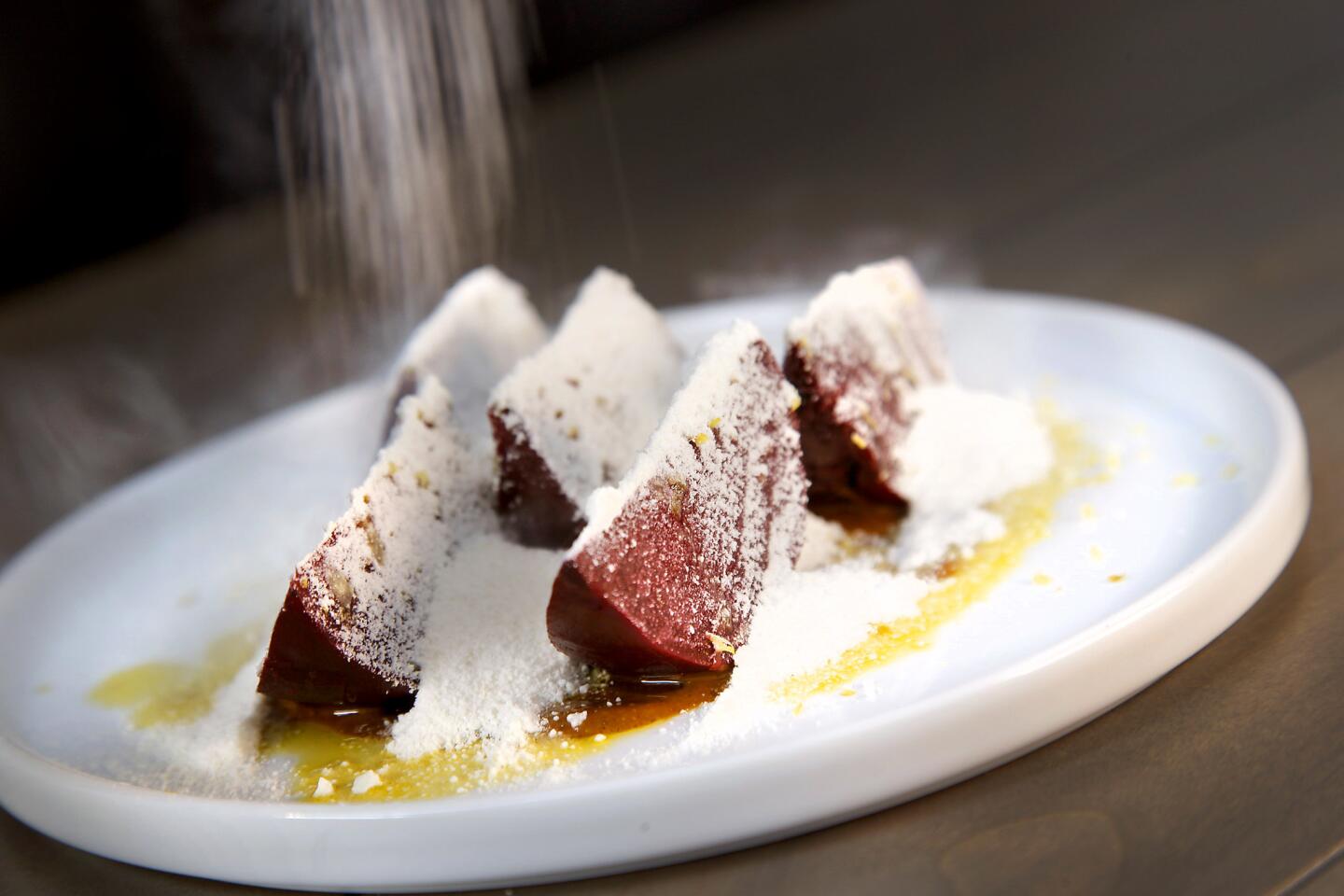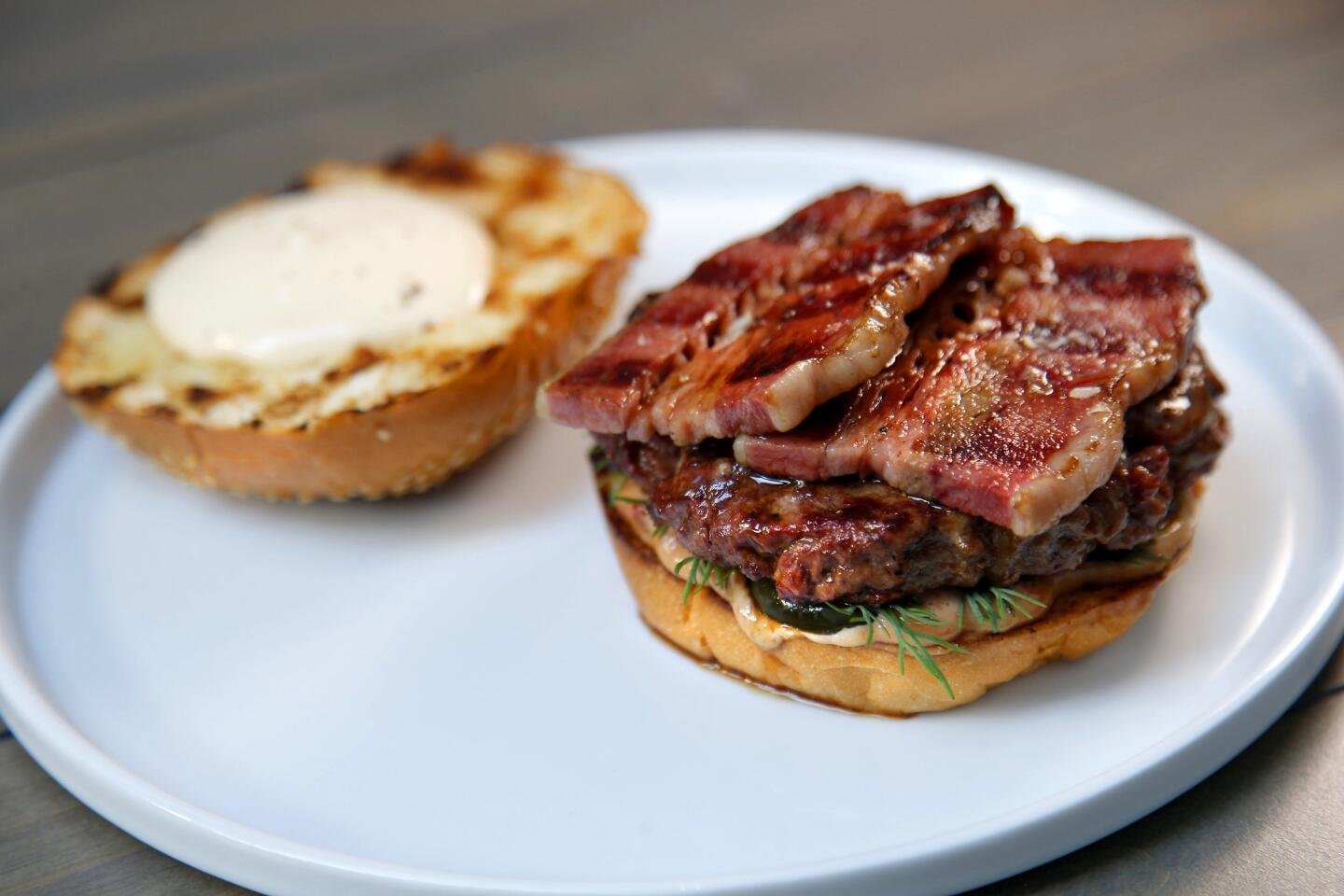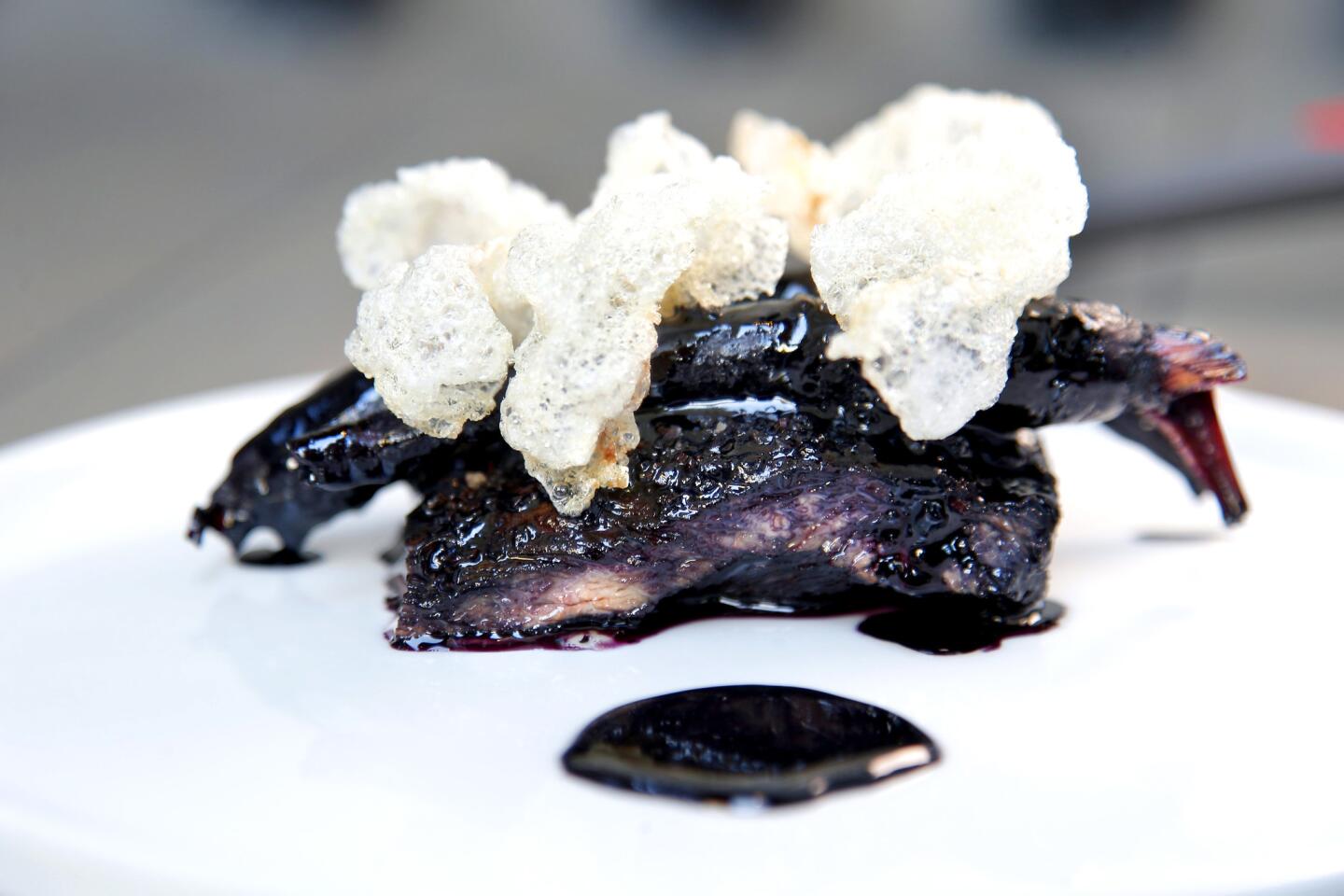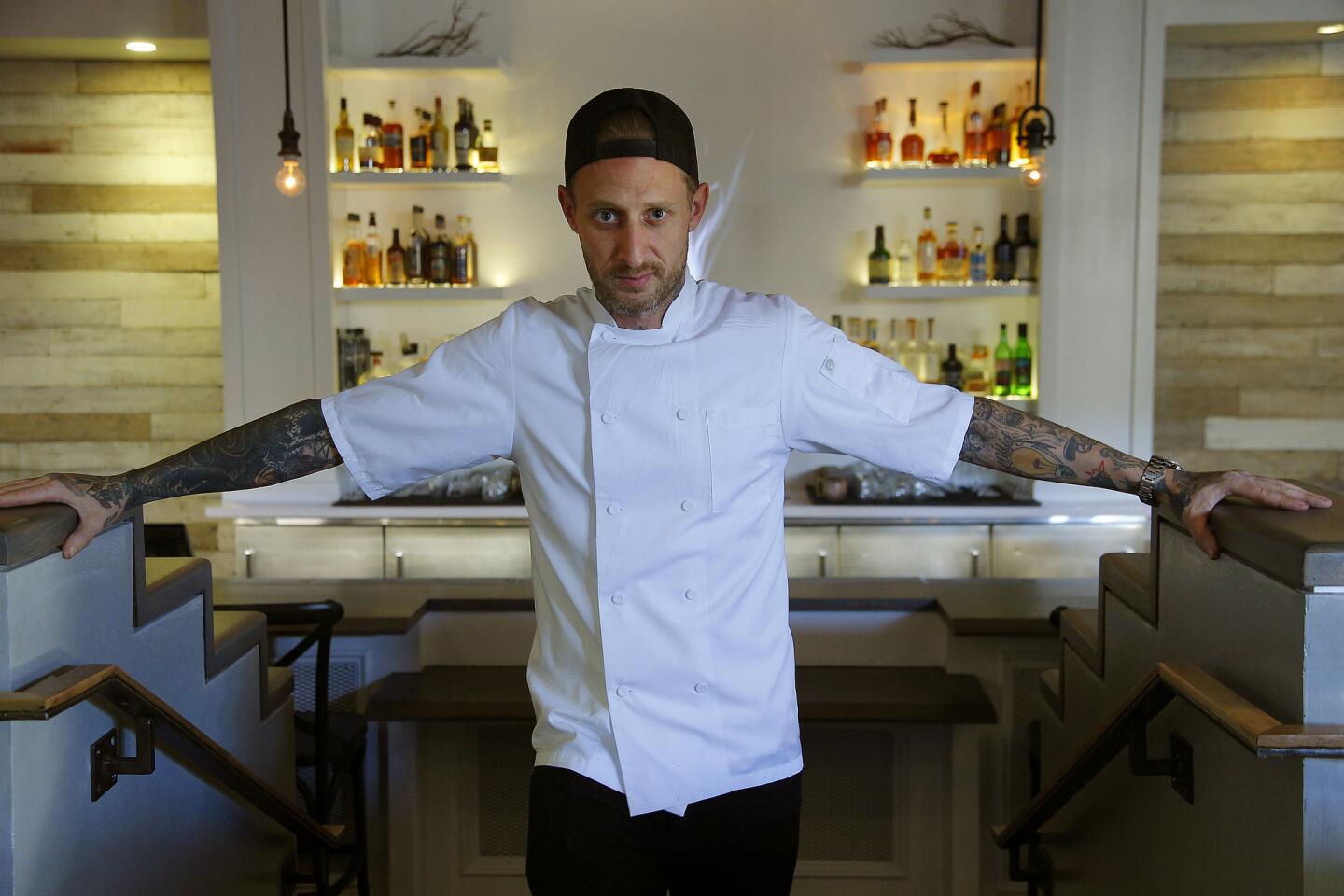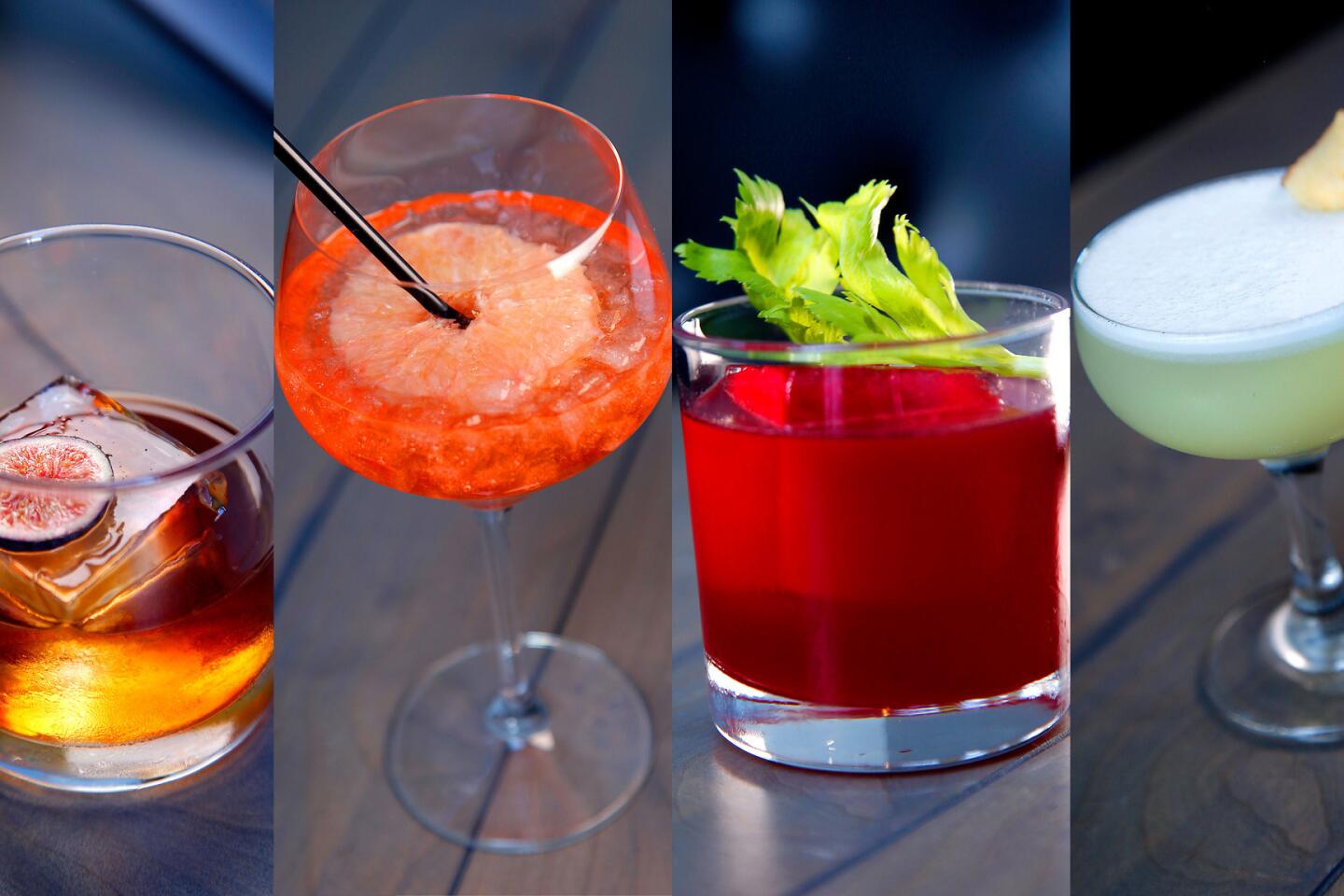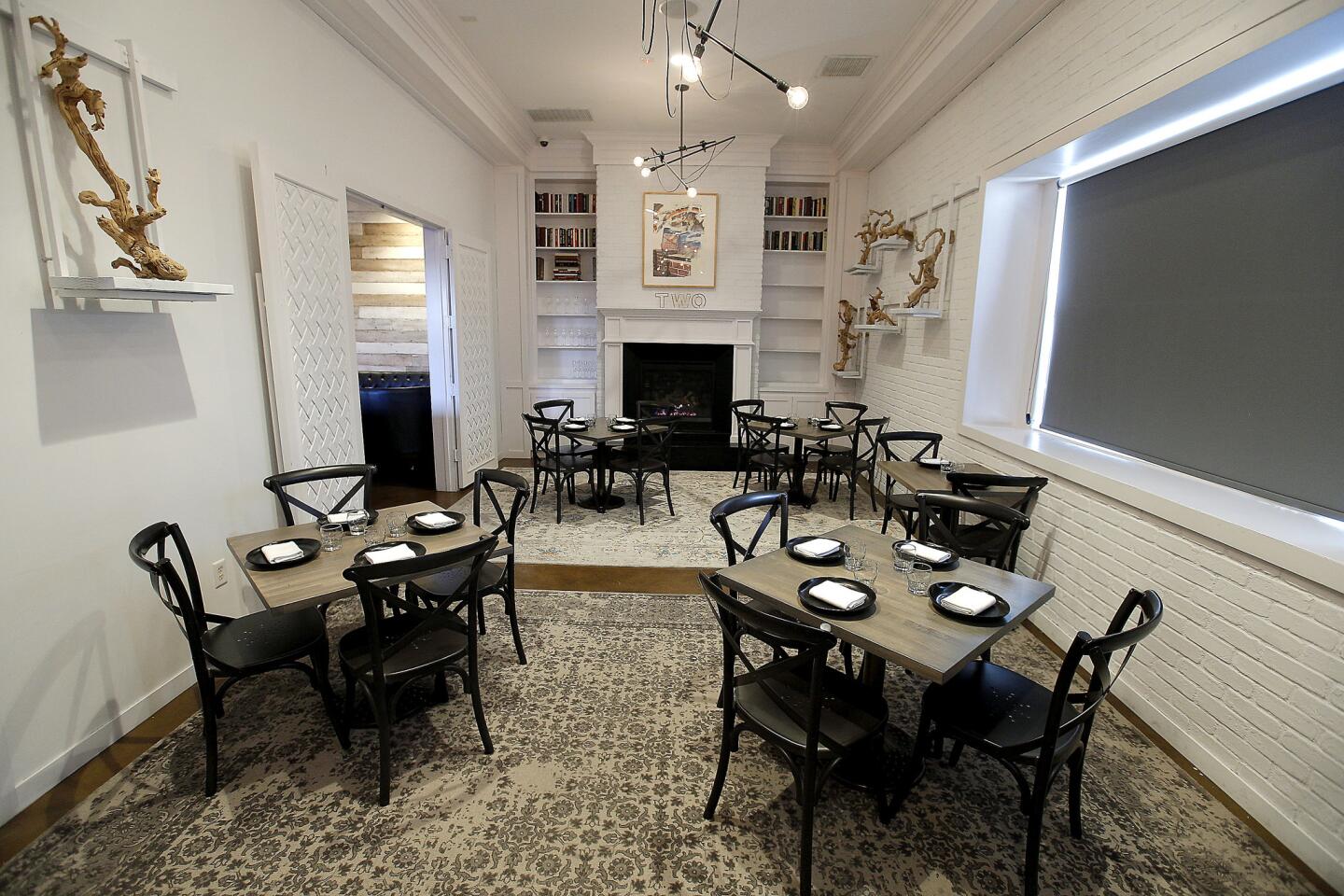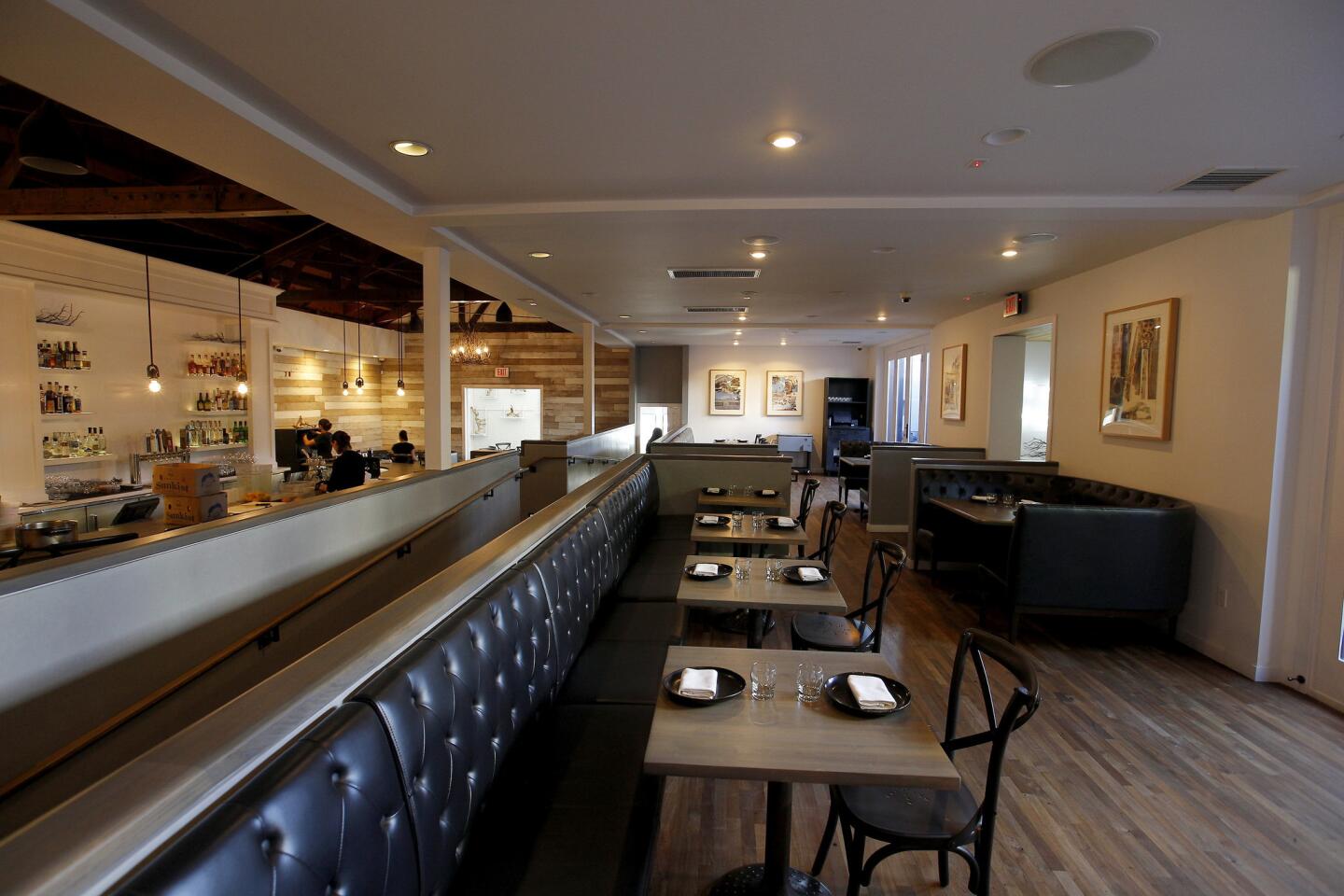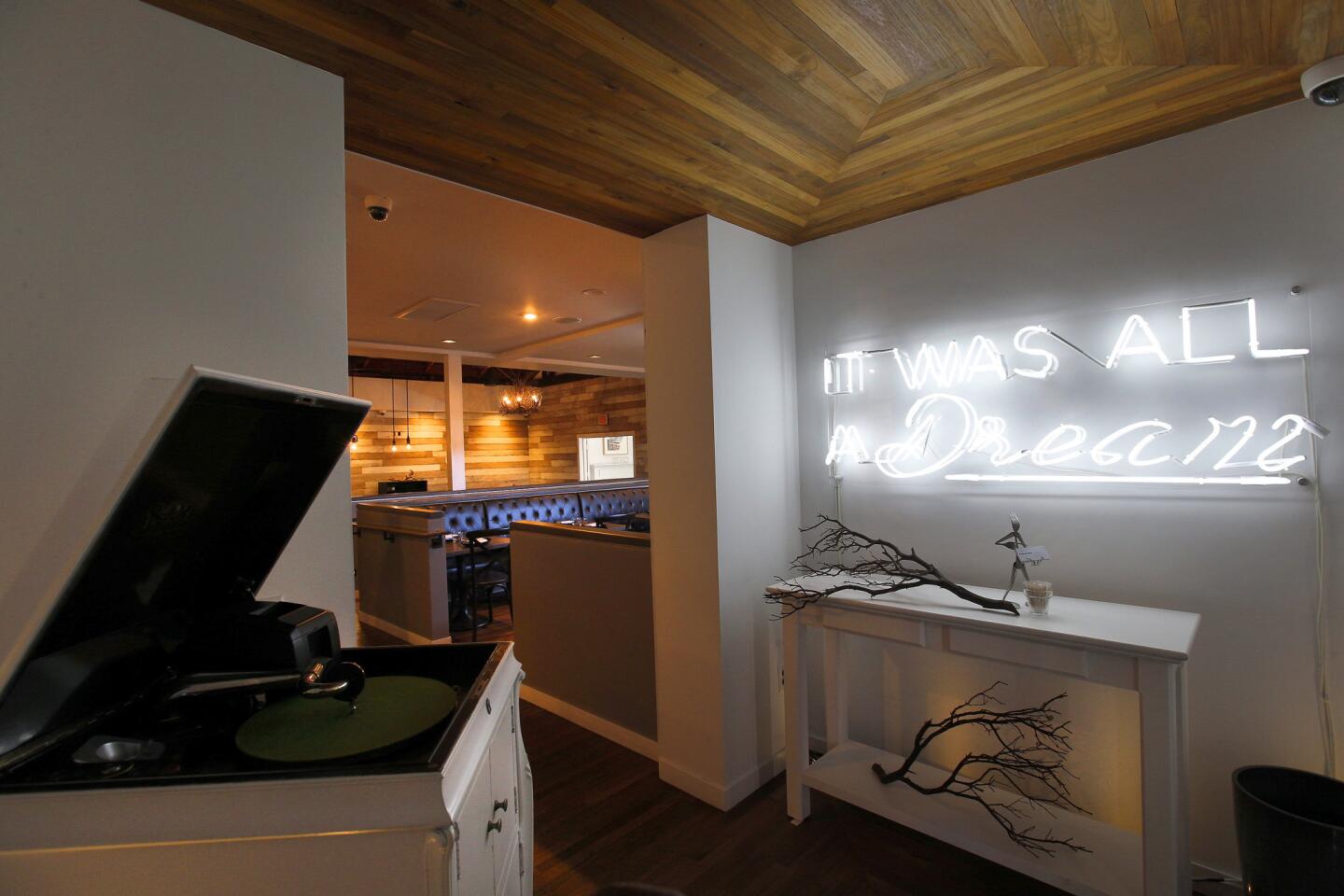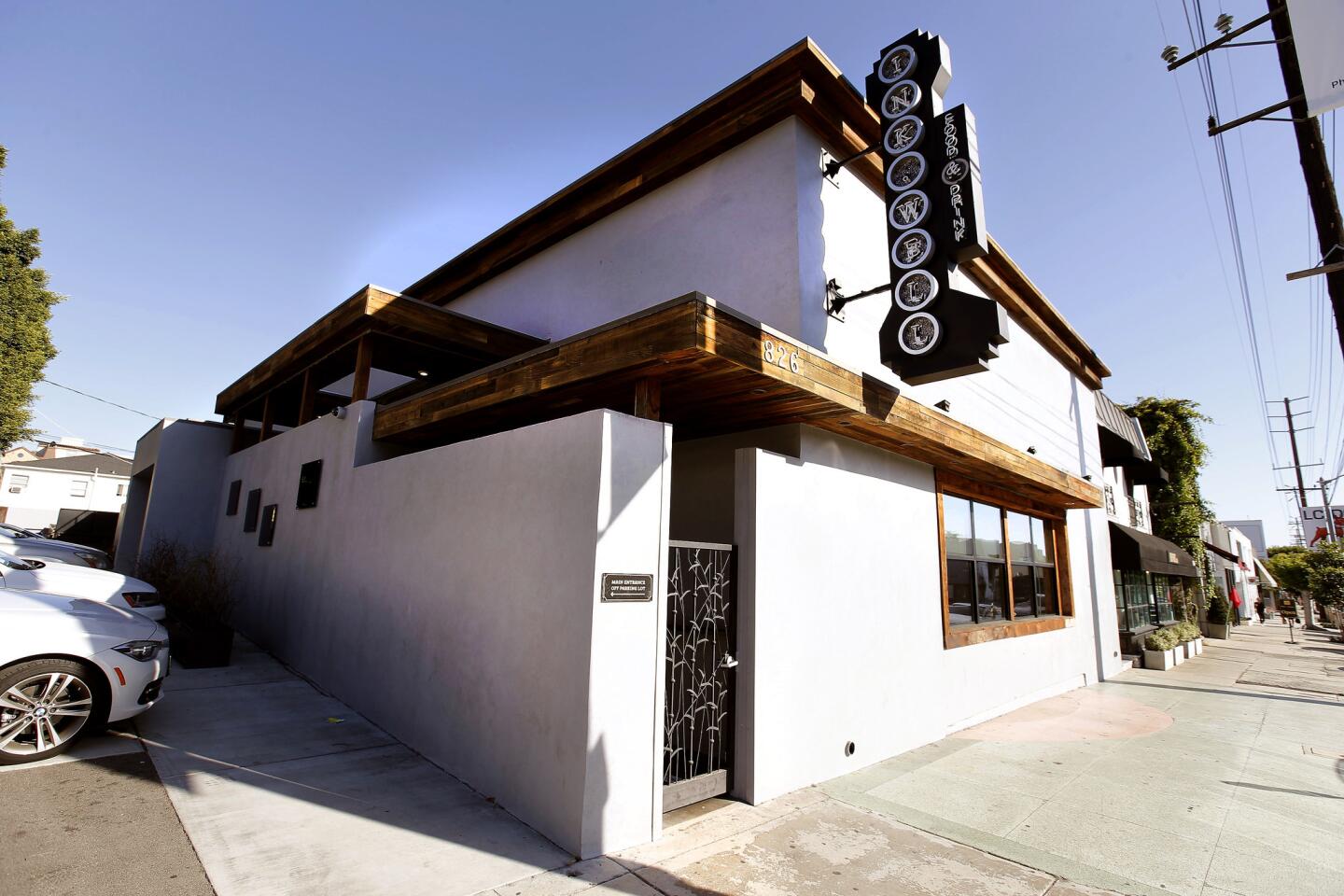Review: Nitrogen and horchata mix at Michael Voltaggio’s latest restaurant
- Share via
Imagine a plate at the new Ink.well, a heavy one whose steeply curved lip is high enough to ensure that a haphazardly placed fork balanced on it slides right down into its contents. The plate’s surface is paved with a thin layer of Mexican-chocolate ganache painted over a macadam of cookie crumbs. There are snowdrifts of the Mexican rice drink horchata quick-blasted with liquid nitrogen and shattered into frozen pebbles. Humps of a softer ganache, made with caramelized white chocolate and striped with hibiscus-flower syrup, peek from the rubble, like plump caterpillars. The plate arrives at the table enshrouded in pale mist.
It is amusing to bite down on the horchata pebbles — thick smoke may erupt from your nose. You become emboldened and chew a big spoonful all at once. You experience what can only be described as an automobile airbag exploding in the back of your mouth. Cheeks puff, cold gas blasts down your throat, and you may emit what sounds like a small seal’s bark. There is a lot of nitrogen trapped in that horchata. You do not feel like this when you dive into a crème brûlée.
If chefs can be divided into those whose dishes you could reasonably duplicate at home and those whose dishes you could not, Michael Voltaggio has always been one of the latter. He first came to notice in Los Angeles as the chef de cuisine at the Bazaar, José Andrés’ modernist Disneyland in the SLS Hotel, and he spent a term doing magic tricks with foams, ices and improbable emulsions at the Langham Huntington. When I profiled him for the old L.A. Times Magazine, the dish he wanted to run was his take on le gargouillou, the infamously complex specialty of the three-star French chef Michel Bras. Voltaggio’s cooking at Ink was fiendishly complex, the sort of thing a young chef could only attempt if he had a closet full of toys, beyond first-rate produce and a team of chefs as eager as he was. Ink, almost everybody thought in 2011, was the future of Los Angeles food.
But haute cuisine is a difficult game, even for a chef as gifted as Voltaggio. Expectations are high, margins are thin, and the attention of the kind of people who jet between Narisawa, Alinea and Arpège is notoriously fickle. Ink was always a hot ticket, but not quite hot enough to fill seats a month in advance. And possibly through his glowering ubiquity on “Top Chef” and the success of the casino steakhouse he runs with his brother, he became something close to a populist chef — not changing his cooking much at all, but with preparations loved less for their innovation than for their deliciousness.
So Ink closed. And almost immediately Voltaggio moved his operation to Ink.well, a larger, brighter, more open place on what used to be Restaurant Row, presumably renamed because of the greater importance of Otello Tiano’s bar program. Ink’s open kitchen has been replaced by a closed laboratory off to one side, the soundtrack leans towards the dance club, and the bar dominates the front dining room.
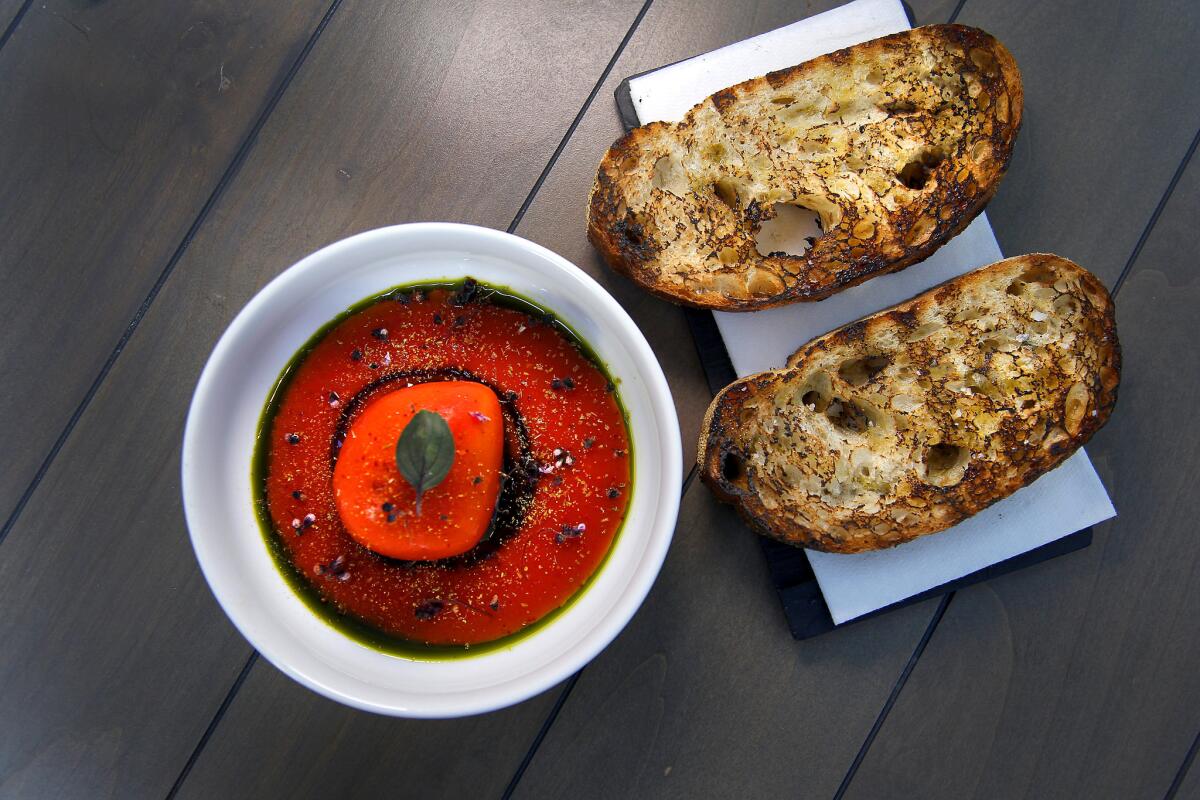
Here’s the smoked mozzarella dressed up like a tomato, with pomodomo sauce with grilled bread.
There is a burger now, albeit one made with loosely packed dry-aged beef, thick slabs of beef-belly “bacon” and a glob of whipped cheese that a server dreamily wished she could pipe into a wading pool. You have probably heard of some of the wines. (I keep ordering the Gewurztraminer from Navarro in the Anderson Valley, whose zing and slight sweetness go pretty well with Voltaggio’s trademark spice and slashing acidity.)
Still, Ink.well is different from Ink mostly within context, the familiarly unfamiliar served in a user-friendly, date-night setting instead of a darkened cave, a place where you can have an Old Fashioned, a salad and a steak, except that the bourbon may be inflected with amaro, the frisée will be garnished with a crunchy haystack of fried pigs’ ear, and the steak is probably going to come with the buttery, seaweed-spiked mashed potatoes that Voltaggio has been serving for what seems like forever.
Perhaps you have tasted the ball of smoked mozzarella glazed to look like a tomato and served with basil leaves and a puddle of thin tomato reduction — it’s how a chef from Bhutan, armed only with a description from Google Translate, might interpret an insalata Caprese. Or maybe you’ve eaten tiny boiled potatoes crusted with salt in the manner of the Canary Islands but also tinted jet-black with charcoal; or egg yolks gelled into gooey-centered gnocchi; or octopus dyed black with ink.
You can marvel at the marinated shrimp under a blizzard of fresh dill — Voltaggio likes putting things under other things — but scooped up with shrimp chips flavored with Old Bay, the taste is of a harborside Baltimore snack. A salad of stalky endive spears concealed under pickled sliced pear and Pacojet-frozen feta cheese — it looks like vegetables but slices and tastes kind of like pizza. Roast beets jut from a frozen snowscape of horseradish-flavored goat cheese like forgotten Antarctic wrecks. Roasted cauliflower — chopped into small bits, surrounded with a moat of yogurt, chickpeas and vadouvan — becomes something like couscous with curry when you mix it all together.
Not everyone likes Voltaggio’s cooking, and it is easy to see why. The nori-infused rigatoni with warm Dungeness crab has stung with salt every time I’ve tried it; I imagine he likes it that way. If you’ve had the Mexican street corn preparations at places like Salazar (or the street!), you would be justified in judging Voltaggio’s sludgy version as over-complex, and the banana-scented grits that come with the braised pork cheeks are just weird. I kind of like the crisp-skinned branzino filets buried under fettuccine made from cuttlefish tossed with lemon, but I do imagine that it would be better as two separate dishes rather than jumbled into one.
I would probably like the steak tartare better if the menu didn’t indicate banh mi flavors that weren’t really present in the dish — the dash of fish sauce, the thicket of cilantro and mint, and the crisp strands of fried onion hinted at Southeast Asia, but in a less than specific way.
But Voltaggio’s cooking does tend to have a there-ness to it that goes a bit beyond words, like the braised pine nuts that act like white beans with the fatty braised lamb belly; the broth-cooked sunflower seeds with the chicken thighs, or the bright purée of nasturtium leaves that appears with the pasta. Can “there-ness’’ make sense in a different “there’’? It already does.
::
Ink.well
Chef Michael Voltaggio relocates and reboots his flagship restaurant
LOCATION
826 N. La Cienega Blvd., Los Angeles, (310) 358-9058, mvink.com.
PRICES
Vegetables and grains $11-$16; seafood $14-$38; meat and poultry $18-$62.
DETAILS
6 p.m. to 10 p.m. daily. Full bar. Credit cards accepted. Valet parking.
RECOMMENDED DISHES
Endive salad; beets with pistachio butter; branzino with cuttlefish noodles; lamb belly with pine nut cassoulet; Mexican chocolate.
MORE FROM JONATHAN GOLD
Jonathan Gold can’t stay away from Grand Central’s Sari Sari Store
Jonathan Gold enters Nothingness and finds somethingness — namely, Thunderbolt frog and BBQ potato
Ricardo Zarate’s Rosaliné is a Peruvian party. Jonathan Gold orders a pisco sour and has some fun
More to Read
Eat your way across L.A.
Get our weekly Tasting Notes newsletter for reviews, news and more.
You may occasionally receive promotional content from the Los Angeles Times.
